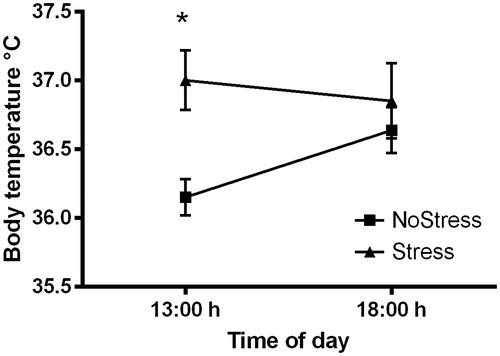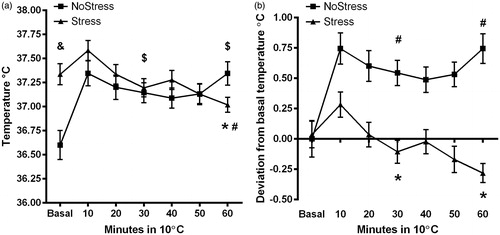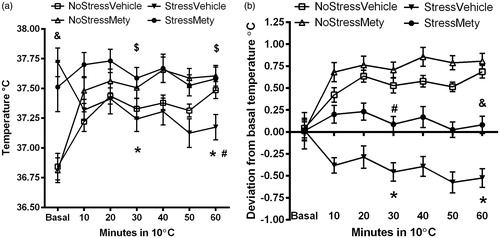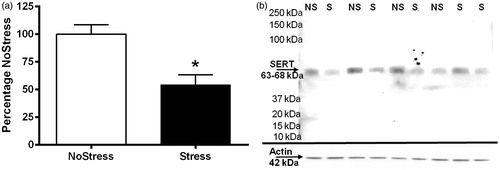Figures & data
Table 1. Chronic unpredictable stress schedule.
Figure 1. Basal subcutaneous (sc.) body temperature measured 4 d after 21 d of chronic unpredictable stress. Stressed rats significantly increased body temperature of 37.00 ± 0.22 °C at 13:00 h compared to NoStress rats (36.15 ± 0.13 °C). Values are mean ± SEM (*p < 0.01) (n = 6–8 per group).

Figure 2. Body temperature (sc.) of NoStress and Stress rats in the cold. Rats were placed in a cold room 4 d after the last stressor and sc. body temperature was recorded. Data were analyzed at basal, 30 and 60 min time points in the cold room. (a) Body temperature in the cold room. Body temperature of Stress rats at 60 min in the cold room was significantly lower than basal (*p < 0.05) and NoStress rats at 60 min in the cold room (#p < 0.05). The basal temperature between NoStress and Stress rats were significantly different (&p < 0.001). NoStress group significantly elevated body temperature from basal in the cold room at 30 and 60 min ($p < 0.001). (b) Change in body temperature in the cold room compared to basal. Body temperature of Stress rats was significantly lower than NoStress rats at 30 and 60 min in the cold room (*p < 0.001). NoStress rats significantly elevated body temperature at 30 and 60 min in the cold room (#p < 0.01) (n = 23–24 per group).

Figure 3. Body temperature (sc.) in cold of Metyrapone (Mety) pretreated rats. Rats were treated with vehicle or 50 mg/kg Mety, 15 min before each stressor. Data were analyzed at basal, 30 and 60 min time points in the cold room. (a) 4 d after the last stressor, rats were placed in a cold room and body temperature was recorded. StressVehicle group significantly decreased body temperature in the cold at 30 and 60 min compared to basal (*p < 0.001). StressVehicle rats were significantly lower than NoStressMety and StressMety at 60 min in the cold (#p < 0.05). The NoStressVehicle and NoStressMety rats significantly increased body temperature at 30 and 60 min in the cold ($p < 0.001). The basal body temperatures between NoStress and Stress groups were significantly different (&p < 0.001). (b) Deviation from basal body temperature in the cold room. Body temperature of StressVehicle rats was significantly lower than all other groups and Mety pretreatment prevented the lack of elevation in body temperature in the cold room (*p < 0.05, StressVehicle vs. all other groups; #p < 0.05 StressMety vs. NoStressMety; &p < 0.05, StressMety vs. NoStressMety and NoStressVehicle) (n = 14–16 per group).

Figure 4. Serotonin transporter (SERT) immunoreactivity in the synaptosomes of the medial preoptic area (mPOA). (A) Exposure to CUS significantly decreased SERT immunoreactivity in the mPOA 4 d after the last stressor (*p < 0.05) (n = 5–7 per group). (b) Representative Western blot for SERT immunoreactivity with actin loading control.

Figure 5. Body temperature (sc.) during cold exposure after serotonin 2A/C receptor agonist DOI injection into the mPOA. Data were analyzed at basal, 30 and 60 min time points in the cold room. (a) Four days after the last stressor, DOI was injected 20 min before rats were placed in a cold room and body temperature was recorded. Stress + DOI significantly increased body temperature at 30 min compared to NoStress + aCSF, NoStress + DOI and Stress + aCSF (*p < 0.05) and at 60 min was significantly different from Stress + aCSF (#p < 0.05). (b) NoStress controls and Stress + DOI treated rats elevated their sc. body temperatures from basal levels in response to cold room exposure 4 d after last stressor. Stress + aCSF treatment significantly decreased body temperature in the cold room compared to all other groups and DOI treatment in Stress rats prior to cold room blocked this effect. (*p < 0.01, Stress + aCSF vs. all other groups at 60 min; &, p < 0.01; Stress + aCSF vs. Stress + DOI at 30 min; #, p < 0.05, Stress + DOI, NoStress + DOI and NoStress + aCSF at 60 min vs. basal) (n = 5–6 per group).

